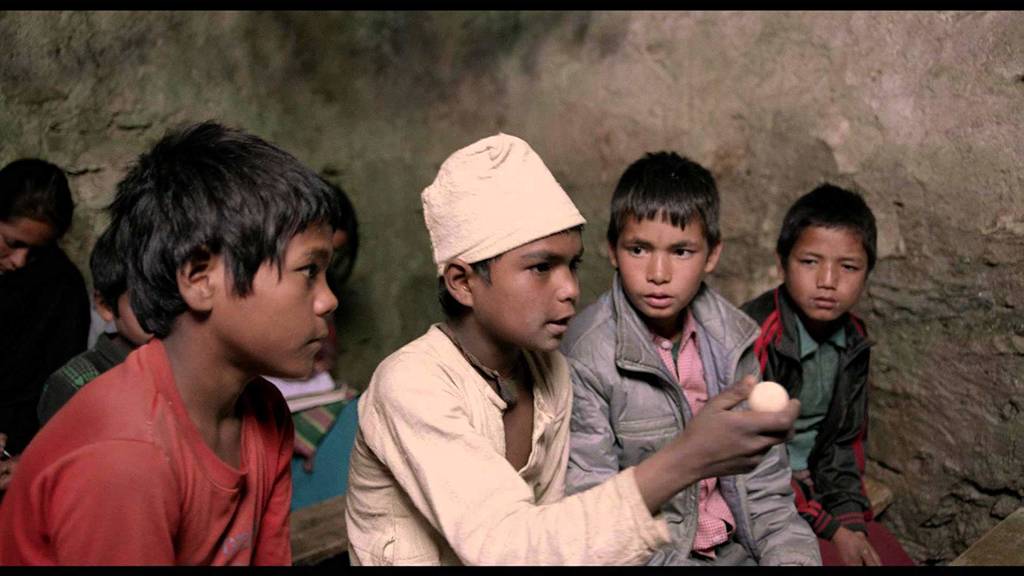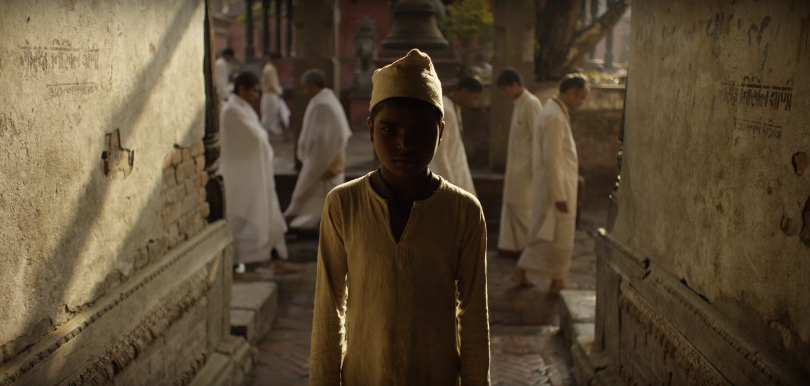Introduction
The movie Kalo Pothi [English: Black Hen] is a Nepali movie directed by Min Bahadur Bham. This movie is set around the northwestern part of Nepal and is the first Nepali movie to be screened at the Venice Film Festival. The highest-grossing Nepali movie overseas, it was also the first Nepali movie entered in the Academy Awards.
The story revolves around two kids — Khadka Raj Nepali as Prakash, Sukraj Rokaya as Kiran. The story is based on the personal life experiences of the director and has an emotional connection to him. The lead character Prakash is an old childhood friend and Kiran reflects the director himself. Through the movie, he is portraying aspects of Nepal that are often neglected in mainstream narratives — the minutiae of village life and the marginalization caused by the caste system that is rarely a focus for Nepal’s urban-centric cinema.[1]Bhamhas successfully infused the production with the real look and feel of his native region.[2]
The movie was released
on September 4, 2014, with an investment of Rupees 30 million. The
director was honored by the then President of Nepal with the National Talent
Award for his contribution to art and culture, and the movie was nominated for the Best Foreign Language Film Oscar.
Summary
The story is set back in 2001,at the time of the civil war in Nepal, where villages like these across the country were victimized by Maoists and governmental forces alike, the former using forced recruitment, the latter using often indiscriminate punitive action against those suspected of being in league with the Maoists (insurgents).[3] Set during the time of war, the movie tells the story of two boys and their friendship: Prakash (Khadka Raj Nepali) grandson of the high-caste head of the village and Kiran (Sukra Raj Rokaya) son of a servant. The story has a gentle flow and is beautifully photographed. However, the village life, caste dynamics, prejudices, and politics might be faintly perplexing for audiences not familiar with the social context of that time. Primarily, the story revolves around these two protagonists against the backdrop of the war. The decisive factor in the story, “The Hen,” and their affection for it binds them together further; but when Prakash’s father sells the bird without their knowledge, Prakash and Kiran are determined to go and bring her back, whatever the cost. Prakash believes that, if they succeed in the retrieval of the bird, his sister, who has fled away to join the Maoists, would return; and so begins a perilous journey that will take them right into the crosshairs of the insurgency, where they encounter horrors they could never have imagined. Brutal dramatic scenes of violence are depicted. The mise-en-scene shows the boys with blood smeared over their faces, pretending to be dead bodies so that the communists will not kill them.[4] The reality of the situation seeps in and the music becomes heavy. The movie comes to an end as they wash their blood-covered bodies and progress onward, finally finding the bird, who has given birth to several chicks. However, Prakash decides to end his pursuit of the hen, opting not to separate the mother from her children, something that reminds him of losing his own mother at a very early stage in his life.
Introduction to the Nepalese Civil War
From 1996 to 2006, there was an armed conflict fought between the Communist Party of Nepal (Maoist) (CPN-M) and The Government of Nepal. The major rebellion was launched on February 13, 1996, with the objective of overthrowing the monarchy in Nepal to establish a People’s Republic. This came to an end with the peace treaty signed on November 21, 2006. The long monarchy of 240 years came to an end and resulted in the Comprehensive Peace Accord Constituent Assembly.
This conflict, known as the “people’s war,” killed 13,000 people and displaced 200,000. With the mobilization of the army in 2001, the conflict intensified,leading to more casualties in 2002. Political workers were at top of the list of people killed, followed by agricultural laborers, reinforcing that the poor are often more vulnerable to conflict risks.[5]
The History of the Emergence of the Maoist Movement
To understand contemporary politics in Nepal, Nepal’s historical events, or even to understand the social context of this movie, one needs to understand how and why the Maoist Movement emerged when Nepal was a democratic country.
There have been two major approaches to understanding this emergency. First, researchers have used cross-sectional regional techniques to predict the effects of poverty, inequality, rough terrain, and ethnolinguistic division on political violence and, second, historical analyses have highlighted the incentives of rebel leaders and the failed policies of the Nepali government to suggest that politics has played a primary role.[6] Maoists strongly believed that the Nepalese society was an oppressed society, the result of the power dynamics at play. To benefit the marginalized and the poor, it was important to uproot the monarchy and the feudalism in this society. As their views gained acceptance by society, they stared acting as the leader of the larger rural population and advanced the movement forward.
Mugu: The Context During the Insurgency
Located in the northwestern part of Nepal, Mugu in one of the biggest districts in Nepal with the lowest human development index. The region is extremely mountainous and borders with Tibet in the north.It is one of the most neglected regions in Nepal, which was crippled by the insurgency. It takes four days to reach the specific village Mugu, and there is no direct airway or roadway. The only means to reach this area is by trekking; however, traditional transportation methods like yak and horse are available. The topography of the region allowed for an easy hideout for the rebels, hence it was densely populated by them and was a major conflict area during that period.
Depicting the Interrelatedness of the Two Parallel Timelines
The movie blends two parallel timelines: one created by the children’s life and imagination, and the other reality depicted as history. The two timelines are portrayed simultaneously in the movie. The movie features cross cutting, where the conflict and the protagonist’s life are shown simultaneously yet parallel to each other. It is a mélange of friendship, tragedy, love, siblings’ bond, and, at the same time, caste discrimination, the effect of warfare.
Set back in early 2000, Kalo Pothi uses folk music and color to harmonize rural life. The movie starts with a shot of the general environment where the villagers are engaged in their day-to-day life. The two main protagonists are bought into the picture with the hen, which is the pivot around which the story revolves. Prakash’s sister (Bijuli) is introduced when she gifts to her brother the hen that she inherited from their late mother. The movie incorporates cross cutting more than a logical classical continuity; the movie does not revolve around a specific individual’s life but simultaneously portrays the lives of several characters along with the history of that time period. Different shots of Maoist influence are shown in the background. House walls are painted with slogans; there are verbal announcements heard in the background; posters of Karl Marx and communist ideologies are shown in the background. The need for fighters for the revolution is referenced by the posters seen hazily in the background of the movie.

Kalo Pothi (Shooney Films, 2015)
As the movie progresses, it focuses on the relation between the two protagonists and how their friendship unites them together, despite coming from different castes. One is the grandson of the leader of the village; the other is the son of the servant working for the leader. Prakash and Kiran go to the same school, play together, share possibly everything they can with each other, without realizing social complexities– and are enchanted with their own innocence. The cross cutting commences from the point where Bijuli joins the guerrillas while Prakash’s father sells the hen to an old man in another village with some fowl. Prakash, deeply affected by his sister’s absence, believes that she will return only when he gets back the hen. Correspondingly, Kiran’s sister, who is also their schoolteacher, is about to marry a soldier; but her plans go awry, as the Maoists interfere and abduct the groom. The boys, however, still focused on their bird-tracking plot, and not realizing the seriousness of the situation, move forward with their mission. Along the way, they suffer trauma and experience violence and killing, which is happening between the army and the guerrillas. Regarding the violence, the movie takes into account the illegal killing and sad stories of innocent people who suffered the consequences of being part of the Maoist struggle.[7] The movie chiefly focuses on the plight of the minority group and poor, who often suffer the most during wars and whose perspective is not usually taken into mainstream account. It depicts the gap between the real political scenario of what happened and how it was portrayed.[8]
Subtle Caste Consciousness
Though made illegal in 1962, the caste system is still prevalent in Nepal, one of the few countries in the world where this is the case. The caste system is a long-running social stratification in Nepal. The Founder of the Shah Dynasty “Prithvi Narayan Shah” and the first King of the Kingdom of Nepal acknowledged the existence of the four varnas (Brahmin, Kshatriya, Vaishya, Sudra) and thirty-six castes borrowed from the Hindu caste system.
However, even after a decade-long civil war, a fallen monarchy, a fledgling democracy, and disastrous, fractured political system, Nepal’s caste system continues to influence everyday life in Nepal.[9] Most affected in this social stratification are the Dalits. Dalits are considered to be the lowest of all castes and are called “untouchables.” Dalits are also excluded from the above-mentioned varna system, referred to instead as the fifth fold, also known as Panchama. The “so-called” high caste people do not eat food or drink water touched by them and they are not allowed to enter into a temple or specific public spaces. The movie vigilantly shows the caste discrimination prevalent in Nepal. In a number of scenes, Kiran (the village leader’s grandson) is addressed decently by the villagers, whether in school or their general day-to-day life; however, Prakash (the Dalit boy), based on the way villagers treat him, it is clear that he is of a lower caste. In different segments, it is also seen that the leader does not like his grandson hanging around with the Dalit boy. The movie also shows how children learn by and adapt to what they see. And it can also be painful to watch the young gradually absorbing these toxic ideas through exposure, going on to replicate them without even realizing it: We see it in the way Kiran brings up Prakash’s lowly standing whenever he’s angry at his friend—while caste is never an issue between the two on good days, it still rears its ugly head on occasion.[10]
Textbook History
Bijuli (Paksha’s sister) occupies an important role in the story. The major aim of the movie, in my view, is to show how the history we read is not the only history that happens, as in there is much more to the story than what is black-letter printed in the textbooks. It is different from the kind of knowledge we are used to dealing with, and its relation to historical experience.[11] Bijuli, to my understanding, reflects the knowledge we are dealing with. Academically, this insurgency, known as the people’s war, was influenced by Mao Tse-tung’s idea of people’s war, and is a military doctrine. It is understood as peasant-based insurgencies, which were deliberately fomented in and from remote and rural areas.[12] As the rural and poor are the ones who have to face the harshest circumstances, giving them new ideas, ideologies, and a platform to make things better is alluring. Similarly, in the case of the Maoists, they framed the local issues into national and ideological issues, providing the lower strata an opportunity to form new opinions and attitudes. Bijuli, belonging to this concentrated Dalit population, saw this insurgency as a tool for a better tomorrow. However, the difficulties she and her family had to face, both before and after, are usually neglected or unseen in the history we read today. In one of the scenes, the police inspector comes to see her father after she has left and threatens to imprison both him and Prakash if they fail to bring her back. Villagers also exclude her father, blaming him for her running away, and his already worsening situation made worse is what the written texts of mainstream history fail to address.
Sociological Imagination – Relation to Movie
Coined by an American sociologist, sociological imagination is an awareness of the relationship between the wider society and personal experience. C. Wright Mill, in his book The Social Imagination,[13] states: “Neither the life of an individual nor the history of the society can be understood without understanding both.” It talks about how our life is not just an outcome of our own actions but also the consequences of history and the society we live in. It talks about how many of our problems are not from our own doing but rather the forces of history and society.
The movie Kalo Pothi has gracefully depicted the idea of social imagination. “Mills’ main point is that many of the problems people face within society have social roots and are shared by many others. These roots are often related to the structure of the society and the changes happening within it.”[14] Similarly, the incidents happening in the movie with each character and the decisions they were making, society had a very great role to play. Bijilu deciding to run away and join the Maoists was not a momentary decision. Her actions were manifold: she was a Dalit girl, treated as an untouchable throughout her life; poverty and this harsh life made her miserable. She saw an opportunity to change this life and she took it, no matter what the costs. Her decision to choose this life was largely influenced by society.
Another example of sociological imagination is found at almost the end of the movie. When Prakash finally finds his beloved hen, he decides not to take her back, even when everything he had done was for the sole purpose of getting her back. Incidents in his life own life had an important role in his course of action. Previously, in the movie, he was quite affected by his mother’s death. He has sequences of dreams about his mother. His sister leaving him alone too had a huge impact on his life. So when he sees the bird with her chick, he decides not to take her, believing she belongs with her chicks and her chicks belong with her. Kalo Pothi portrays the idea of social imagination in the different actions taken by the characters, with society playing a huge role in the decisions made by them.
Conclusion
Kalo Pothi is one of the very few exceptional stories in Nepalese cinema. Nepal’s Kollywood film industry (confusingly, India’s Tamil-language film industry, based in Chennai, is also often called Kollywood) is relatively undeveloped and relies heavily on talent and resources from Bollywood.[15] The major problem according to industry experts is that films are being produced more in terms of quantity than quality. Authenticity and creativity are lacking in the movies being produced due to the limited research done before producing the movie. Despite various problems, movies like Kalo Pothi are an encouraging sign for the future of the industry.
Kalo Pothi is not a perfect movie, but it does have its strengths. The director has captured the essence of rural life, the peace that is there even during the war, which written history does not often portray.
Author Biography
Dikshya Koirala is a student at Nalsar University of Law, Hyderabad, India.
[1]Sophia Pande, “Kalo Pothi,” The Nepal Times, June 17-23, 2016, https://archive.nepalitimes.com/article/must-see/Kalo-pothi-review,3101.
[2] Smriti Basnet, “Kalo Pothi: Narrating Nepal,” Glocal Khabar, June 10, 2016, 11:03AM, https://glocalkhabar.com/featured/kalo-pothi-narrating-nepal/.
[3] Sophia Pande, “Kalo Pothi,” The Nepal Times, June 17-23, 2016, https://archive.nepalitimes.com/article/must-see/Kalo-pothi-review,3101.
[4] Peter Bradshaw, “The Black Hen Review – War Invades Bucolic Calm in Nepalese War Drama,” The Guardian, December 8, 2016, https://www.theguardian.com/film/2016/dec/08/the-black-hen-review-min-bahadur-bham.
[5] Bishwa Nath Tiwari, “An Assessment of the Cause of Conflict in Nepal, Himalayan Research Paper Archive,”September17, 2007, https://digitalrepository.unm.edu/cgi/viewcontent.cgi?referer=https://www.google.co.in/&httpsredir=1&article=1033&context=nsc_research.
[6] Avidit Achary, “The Maoist Insurgency in Nepal and the Political Economy of Violence,” October 10, 2009, http://stanford.edu/~avidit/maoist.pdf.
[7] Shreedeep Rayamajhi, “Kalo Pothi a Different Movie in the Face of Maoist Struggle,” Kathmandu Blogging, June 7, 2016, 7:34 AM, http://shreedeeprayamajhi.blogspot.com/2016/06/kalo-pothi-different-movie-in-face-of.html.
[8]Ibid.
[9]“The Decaying Decadence of Nepal’s Caste System,” The Longest Way Home, November 5, 2012, https://www.thelongestwayhome.com/blog/nepal/nepalese-caste-system-culture-in-nepal-today/.
[10]Ibid.
[11] Hilda D. Oakeley, “Reality in History,” Philosophy, vol.6, October 1931, https://www.jstor.org/stable/3746164?seq=1#metadata_info_tab_contents.
[12] Renske van der Wal, “The Nepalese Youth in the Maoist Insurgency,” Bachelor Thesis, Dr. Mario Fumerton Liberal Arts University, February 28,2014, https://webcache.googleusercontent.com/search?q=cache:gH49pC5JSAcJ:https://dspace.library.uu.nl/bitstream/handle/1874/302255/Thesis%2520Renske%2520van%2520der%2520Wal.pdf%3Fsequence%3D1%26isAllowed%3Dy+&cd=7&hl=en&ct=clnk&gl=in.
[13] C. Wright Mill, The Social Imagination, page 3, file:///C:/Users/lenovo/Downloads/The%20Sociological%20Imagination%20(%20PDFDrive.com%20).pdf
[14] Joachim Vogt Isaksen, “The Sociological Imagination: Thinking Outside the Box,” Popular Social Science, April 29, 2013, http://www.popularsocialscience.com/2013/04/29/the-sociological-imagination-thinking-outside-the-box/.
[15] Anya Kordecki, “Kollywood: The Essential Films of Nepal,” Culture Trip, April 21, 2017, https://theculturetrip.com/asia/nepal/articles/kollywood-the-films-of-nepal/.









































